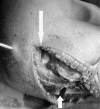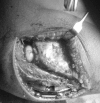Treatment of chronic radial head dislocations in children
- PMID: 16741732
- PMCID: PMC2267559
- DOI: 10.1007/s00264-006-0153-4
Treatment of chronic radial head dislocations in children
Abstract
From 1990 to 2005 our department treated nine patients with chronic radial head dislocation by an ulnar osteotomy and indirect reduction by interosseous membrane. The patients varied in age from 2 years and 8 months to 10 years, and the time from the injury to operation ranged from 40 days to 3 years. The range of functional motion and carrying angle was restored in all nine patients, and no complications, such as recurrent dislocation, infection, or neurovascular injury were observed. This technique has proven to be a successful approach to treating such cases, with a low range of complications and good functional results.
De 1990 à 2005 nous avons traité 9 patients, agés de 2 ans 8 mois à 10 ans, d’une luxation permanente de la tête radiale par une ostéotomie cubitale avec réduction indirecte par la membrane inter-osseuse. Le délai entre le traumatisme et la chirurgie était de 40 jours à 3 ans. L’amplitude de mobilité et l’axe du coude étaient restaurés dans tous les cas sans complication à déplorer. Les auteurs sont satisfaits de cette technique.
Figures





References
-
- {'text': '', 'ref_index': 1, 'ids': [{'type': 'PubMed', 'value': '6029027', 'is_inner': True, 'url': 'https://pubmed.ncbi.nlm.nih.gov/6029027/'}]}
- Bado JL (1967) The Monteggia lesion. Clin Orthop 50:71–86 - PubMed
-
- {'text': '', 'ref_index': 1, 'ids': [{'type': 'PubMed', 'value': '5846773', 'is_inner': True, 'url': 'https://pubmed.ncbi.nlm.nih.gov/5846773/'}]}
- Bell Tawse AJS (1965) The treatment of Malunited Anterior Monteggia Fractures in children. J Bone Joint Surg 47B:718–723 - PubMed
-
- {'text': '', 'ref_index': 1, 'ids': [{'type': 'PubMed', 'value': '8188833', 'is_inner': True, 'url': 'https://pubmed.ncbi.nlm.nih.gov/8188833/'}]}
- Best TN, Orth AF (1994) Management of old unreduced Monteggia fracture dislocations of the elbow in children. J Pediatr Orthop 2:193–198 - PubMed
-
- {'text': '', 'ref_index': 1, 'ids': [{'type': 'PubMed', 'value': '709721', 'is_inner': True, 'url': 'https://pubmed.ncbi.nlm.nih.gov/709721/'}]}
- Bouyala JM, Chestrian P, ramaherison P (1978) L’osteotomie haute du cubitus dans le traitment de la luxations anterieure residuelle après fracture de Monteggia. Chir Pediatr 19:201–203 - PubMed
-
- Blount WP (1954) Fractures in children. Baltimore, Williams and Wilkins
MeSH terms
LinkOut - more resources
Full Text Sources
Other Literature Sources
Medical

